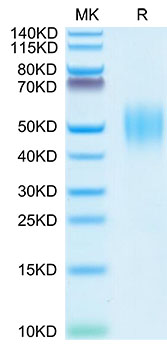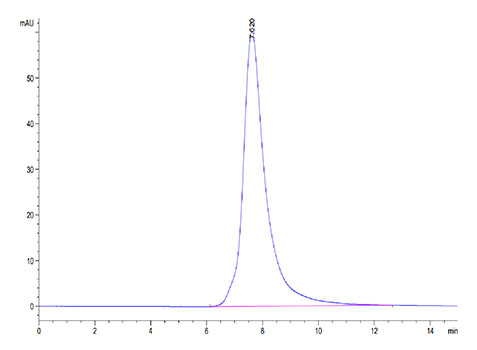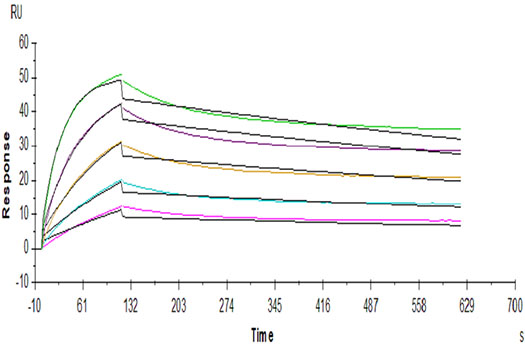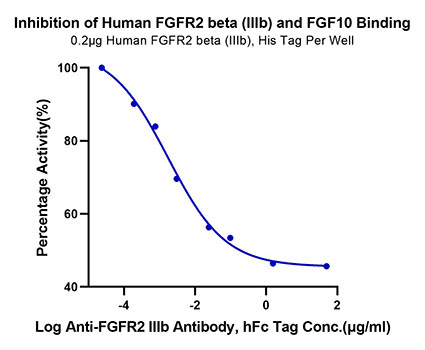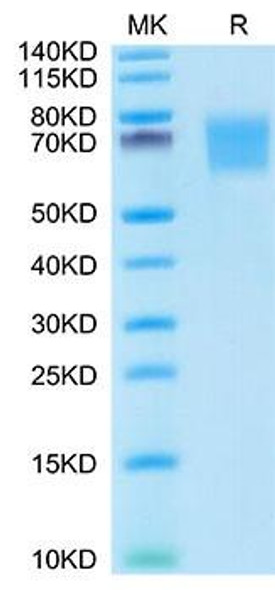Description
Recombinant Human FGFR-2 beta (IIIb)/KGFR/CD332 Protein
The Recombinant Human FGFR-2 beta (IIIb)/KGFR/CD332 Protein is a biologically active recombinant protein that plays a significant role in various cellular processes and signaling pathways in human biology. This protein is widely employed in immunological research, cell biology studies, protein-protein interaction analyses, and therapeutic development, providing researchers with a reliable tool for investigating FGFR-2 beta (IIIb)/KGFR/CD332 function and its implications in health and disease.
This product (SKU: RPCB1598) is produced using HEK293 cells and features a C-His tag for convenient detection and purification. The protein exhibits a calculated molecular weight of 26.5 kDa with an observed molecular weight of 45-60 kDa under denaturing conditions, achieving ≥ 95 % as determined by Tris-Bis PAGE;≥ 95 % as determined by HPLC., ensuring exceptional quality and consistency for research applications.
Key Features
| High Purity by Affinity Chromatography | |
| Mammalian & Bacterial Expression Systems | |
| High lot-to-lot consistency via strict QC |
| Product Name: | Recombinant Human FGFR-2 beta (IIIb)/KGFR/CD332 Protein |
| SKU: | RPCB1598 |
| Size: | 100 μg |
| Reactivity: | Human |
| Synonyms: | Fibroblast growth factor receptor 2;FGFR-2;KGFR;K-sam;Keratinocyte growth factor receptor;CD332;BEK;KSAM |
| Tag: | C-His |
| Expression Host: | HEK293 cells |
| Calculated MW: | 26.5 kDa |
| Observed MW: | 45-60 kDa |
| Gene ID: | 2263 |
| Protein Description: | High quality, high purity and low endotoxin recombinant Recombinant Human FGFR-2 beta (IIIb)/KGFR/CD332 Protein (RPCB1598), tested reactivity in HEK293 cells and has been validated in SDS-PAGE.100% guaranteed. |
| Endotoxin: | < 1 EU/μg of the protein by LAL method. |
| Purity: | ≥ 95 % as determined by Tris-Bis PAGE;≥ 95 % as determined by HPLC. |
| Reconstitution: | Centrifuge the tube before opening. Reconstitute to a concentration of 0.1-0.5 mg/mL in sterile distilled water. Avoid vortex or vigorously pipetting the protein. For long term storage, it is recommended to add a carrier protein or stablizer (e.g. 0.1% BSA, 5% HSA, 10% FBS or 5% Trehalose), and aliquot the reconstituted protein solution to minimize free-thaw cycles. |
| Storage: | Store at -20℃.Store the lyophilized protein at -20℃ to -80 ℃ up to 1 year from the date of receipt. After reconstitution, the protein solution is stable at -20℃ for 3 months, at 2-8℃ for up to 1 week. |
Four distinct genes encoding closely related FGF receptors, FGF R1 - 4, are known. All four genes for FGF Rs encode proteins with an N-terminal signal peptide, three immunoglobulin (Ig)-like domains, an acid-box region containing a run of acidic residues between the IgI and IgII domains, a transmembrane domain and the split tyrosine-kinase domain. Multiple forms of FGF R1 - 3 are generated by alternative splicing of the mRNAs. A frequent splicing event involving FGF R1 and 2 results in receptors containing all three Ig domains, referred to as the alpha? isoform, or only IgII and IgIII, referred to as the beta? isoform.


